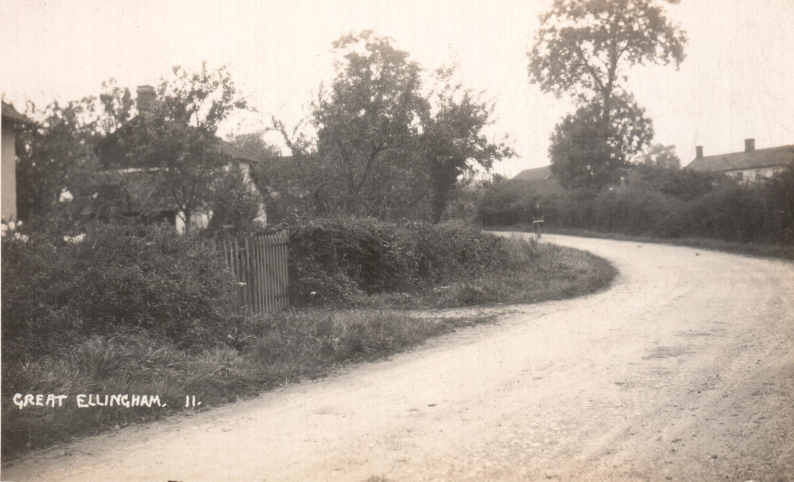A Workhouse was intended to provide work and shelter for the most poverty stricken members of society. However, many of the Victorian Workhouses operated with prison-like conditions. Accordingly it was only the desperate who would seek the shelter of the workhouse.
Nevertheless by the latter part of the Victorian era, workhouses became more of a refuge for the elderly and sick. However, it would seem that those inmates who were financially able to do so, were expected to contribute towards their keep.
East Harling Petty Sessions
The Thetford & Watton Times of the 27th October, 1883, published a report of some of the recent cases at the East Harling Petty Sessions. Amongst the defendants is Great Ellingham miller, Nehemiah Carter.

Wayland Union Workhouse. Courtesy Liz Barrett
Carter had been brought before the Magistrates by William Owen, the Loan & Contribution Officer of the Wayland Union Workhouse at Rocklands.
Elizabeth Carter was an inmate at the Workhouse and Nehemiah was expected to contribute towards his wife’s maintenance whilst she was there. However, by all accounts he had failed to do so.
In the event, the Magistrates found in Owen’s favour. Consequently, Carter was ordered to pay 3s 6d (three shillings and sixpence) per week with an additional sum of £1 11s (one pound and eleven shillings) for costs.
Nehemiah Carter
Nehemiah Carter was born in Great Ellingham in the Spring of 1851.
Long Street

Long Street
Courtesy Carol Ewin
His birth (which took place after the census date of 30th March), likely took place at the family’s home in Long Street.
The 1851 census captures his parents, James and Jemima Carter, in Long Street with their five children. The Great Ellingham Tithe documentation of 1843 shows James Carter as occupying a cottage with pightle owned by Edward Houchen. This dwelling later became known as Homeleigh Cottage.
Church Street
Nehemiah spent at least the first 20 years of his life living with his parents and siblings in the village. By 1871, the Carter family had moved from Long Street to Church Street. At 19, Nehemiah was employed as a baker.
Move to Sussex
However by 1881, Nehemiah had moved away from the village. The 1881 census captures 25 year old Nehemiah lodging in Bishopstone, Sussex. He is now working as a miller.
Marriage & Return to Great Ellingham
During the early part of 1882, Nehemiah married Elizabeth Ann Organ. Not long after the marriage, Nehemiah brought his Somerset born wife to Great Ellingham. Within a year of the marriage, Elizabeth Carter was an inmate in the Wayland Union Workhouse.
Birth of First Child in the Workhouse
I believe that Elizabeth Carter had gone into the ‘workhouse’ to give birth to the couple’s first child, a daughter Ethel Jane. Ethel’s birth was registered in the December Quarter of 1883. This coincides with Nehemiah’s court appearance for non-payment of charges for Elizabeth’s maintenance. Sadly, Ethel Jane died the following year.
The Street

Church Street (formerly known as ‘the Street’) near to the junction with Chequers Lane/Long Street
Nonetheless, the 1891 census finds 40 year old Nehemiah Carter with his 27 year old wife Elizabeth Ann living in ‘the Street’ (now Church Street), Great Ellingham. The couple have four children – Edward James 5, Clara May 3, Evan Sidney 2 and infant Sidney George. Nehemiah’s widowed father James Carter is with the household. Nehemiah is employed as a miller and baker. Perhaps he is working at the mill in Church Street. At 73, James Carter is working as an agricultural labourer.
Move to Croydon
Ten years later, this Carter family moved away from the village. The 1901 census finds Nehemiah and Elizabeth with 5 children living in Croydon. Daughter Cicely was born in Great Ellingham in 1893. They have taken in a boarder.
Nehemiah is working as a miller. His son Edward (now aged 15) is working as a plumber’s labourer and his 13 year old daughter May is employed as a domestic servant.
Discrepancy in Age
Given that the 1891 census shows an age difference of some 13 years between Nehemiah and his wife Elizabeth, the 1901 census shows the age gap to be reduced to 4 years!
Considering that the ages given by Nehemiah and Elizabeth at the time of the 1891 census were correct, I wonder why the couple did not reveal their true age on the 1901 census. Was it merely that they did not want the general public to know of the large age gap between them. However in the past it was not uncommon to find that individuals fibbed about their age!
1911 census
I do not believe that Nehemiah Carter returned to live in Great Ellingham.
At the time of the 1911 census, Nehemiah and Elizabeth are living in a 4-roomed dwelling in Canning Town, West Ham. Again the couple have provided incorrect ages on the census.
Nehemiah and Elizabeth have been married for 28 years during which time, Elizabeth has given birth to 7 children, six of whom are still living. The couple still have son Sidney (now 20) and Cicely (18) with them along with their youngest daughter Doris aged 7. Nehemiah is working as a flour miller. Sidney is employed as a toolmaker and Cicely as a confectionary maker.
Death of Nehemiah Carter
Great Ellingham born Nehemiah Carter died in 1929. His death was registered in the West Ham District with his correct age of 78!
Sources:
The Victorian Workhouse website. accessed 28.03.2024
GRO Index. Also available FreeBMD
1851 census HO107/1823/129
1861 census RG9/1237/78
1871 census RG10/1841/87
1881 census RG11/1073/88
1891 census RG12/1549/69
1901 census RG13/639/157
1911 census RG14/9480/347
27th October, 1883. Thetford & Watton Times. Viewed via The British Newspaper Archive
Tithe Apportionments, 1836-1929 [database online]. TheGenealogist.co.uk 2024. IR29 Tithe Commission and successors: Tithe Apportionments. The National Archives. Viewed via The Genealogist website.